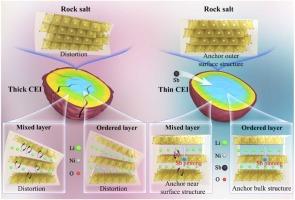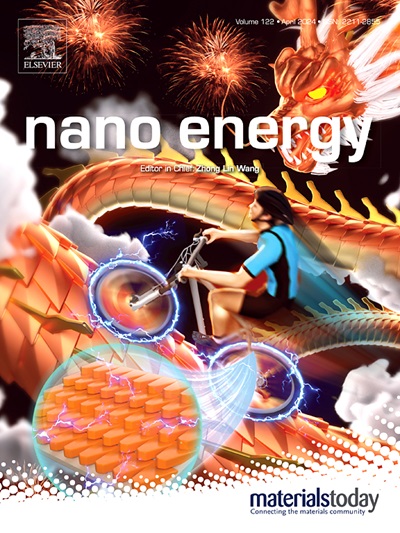Sb-anchoring single-crystal engineering enables ultra-high-Ni layered oxides with high-voltage tolerance and long-cycle stability
IF 16.8
1区 材料科学
Q1 CHEMISTRY, PHYSICAL
引用次数: 0
Abstract
Ni-rich layered oxides are promising cathodes for Li-ion batteries, but the inherent structural defects result in severe surface/bulk degradation during long cycling, especially at high cutoff voltage. Herein we propose a Sb-anchoring single-crystalline engineering to enhance the microstructural and electrochemical stability of ultra-high-Ni layered oxides, where the surface-enriched Sb doping inhibits Li-Ni mixing, suppressing the undesired layered to mixed/rock-salt phase transformation; the bulk-doped Sb rivets into Ni sites, reinforcing the bulk phase stability; the single-crystal endows enhanced crack resistance and reduced surface area, preventing surface parasitic reactions and the subsequent proliferation of cathode electrolyte interfaces. In-situ XRD reveals an essential correlation between cycle stability and phase reversibility, whereas Sb doping into both surface and bulk structures showcases a continuous anchoring effect, largely enhancing the phase transformation reversibility. DFT calculations prove a high oxidation tolerance, as Ni2+ diffusion barrier is higher than the pure cathode. A representative Li(Ni0.9Co0.05Mn0.05)0.99Sb0.01O2 cathode exhibits a high-voltage up to 4.6 V, and a Li(Ni0.9Co0.05Mn0.05)0.99Sb0.01O2//graphite full-cell demonstrates an ultra-high capacity retention of 93.4 % after 1000 cycles at 1 C in 3.0−4.2 V. This simple and efficient cathode engineering will promote the promising application of Ni-rich layered oxides in high-energy Li-ion batteries.

掺锑单晶工程实现了具有高压耐受性和长周期稳定性的超高镍层状氧化物
富镍层状氧化物是很有前途的锂离子电池阴极,但其固有的结构缺陷会导致长时间循环过程中严重的表面/块体降解,尤其是在高截止电压下。在此,我们提出了一种掺锑单晶工程来增强超高镍层状氧化物的微观结构和电化学稳定性,其中表面富集的掺锑抑制了锂镍混合,从而抑制了从层状到混合/岩盐相的不良转变;块状掺杂的锑铆入镍位点,增强了块状相的稳定性;单晶具有更强的抗裂性和更小的表面积,防止了表面寄生反应和随后阴极电解质界面的扩散。原位 XRD 揭示了循环稳定性与相可逆性之间的重要关联,而在表面和块体结构中掺入掺锑则显示了持续的锚定效应,在很大程度上提高了相变的可逆性。DFT 计算证明,由于 Ni2+ 扩散阻力高于纯阴极,因此具有很高的氧化耐受性。具有代表性的 Li(Ni0.9Co0.05Mn0.05)0.99Sb0.01O2 阴极显示出高达 4.6 V 的高压,而 Li(Ni0.9Co0.05Mn0.05)0.99Sb0.01O2/石墨全电池在 1 C 下循环 1000 次后显示出 93.4% 的超高容量保持率。这种简单高效的正极工程将促进富镍层状氧化物在高能锂离子电池中的应用。
本文章由计算机程序翻译,如有差异,请以英文原文为准。
求助全文
约1分钟内获得全文
求助全文
来源期刊

Nano Energy
CHEMISTRY, PHYSICAL-NANOSCIENCE & NANOTECHNOLOGY
CiteScore
30.30
自引率
7.40%
发文量
1207
审稿时长
23 days
期刊介绍:
Nano Energy is a multidisciplinary, rapid-publication forum of original peer-reviewed contributions on the science and engineering of nanomaterials and nanodevices used in all forms of energy harvesting, conversion, storage, utilization and policy. Through its mixture of articles, reviews, communications, research news, and information on key developments, Nano Energy provides a comprehensive coverage of this exciting and dynamic field which joins nanoscience and nanotechnology with energy science. The journal is relevant to all those who are interested in nanomaterials solutions to the energy problem.
Nano Energy publishes original experimental and theoretical research on all aspects of energy-related research which utilizes nanomaterials and nanotechnology. Manuscripts of four types are considered: review articles which inform readers of the latest research and advances in energy science; rapid communications which feature exciting research breakthroughs in the field; full-length articles which report comprehensive research developments; and news and opinions which comment on topical issues or express views on the developments in related fields.
 求助内容:
求助内容: 应助结果提醒方式:
应助结果提醒方式:


